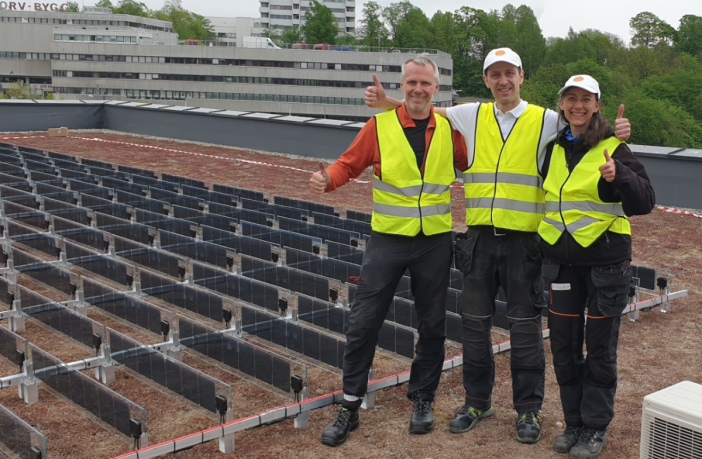- Norwegian startup Over Easy Solar AS has finalized the first pilot project to use its vertical solar module technology for rooftop applications.
“The 5 kW system was deployed in a school building in Oslo,” CEO Trygve Mongstad told pv magazine. “We applied our modularized solution at a height of 31.4 cm above the rooftop with no need for ballast or fastening, and we are now validating it for application in each building and local wind conditions.”
The PV system is owned by Oslo municipality, which provided support through its Smart Oslo innovation fund. The system will be used mainly for self-consumption and will also sellexcess power at spot prices to the grid under Norway’s net metering scheme.
“The orientation we chose here gives a peak at around 11 am in the morning, and a second peak at around 7 pm in the afternoon,” Mongstad explained, referring to the advantages of deploying vertical solar arrays at high latitudes. “There is most activity here early in the day and in the evening when the school is used for other extracurricular activities.”
Andreas Nilsen, energy and environmental adviser for municipal enterprise Oslobygg, said the energy production matches the school’s demand profile “perfectly.”
Over Easy Solar used 150 of its special solar panels, which are based on heterojunction solar cell technology. They have an efficiency of 22% and a bifaciality of up to 92%. Their temperature coefficient is -0.26 C. The panels were installed in 50 vertical PV units.
The units consist of a mounting system and solar panels in a single pre-assembled piece, so they can be mounted more quickly. The geometry with low-building vertical panels has no or very low need for fastening or ballast, which further simplifies the mounting job. Each unit measures 1,600 mm x 1,510 mm x 350 mm and weighs 24.5 kg. It also features an IP68 enclosure rating and 3.2 mm double-tempered glass.
“We are working to take down costs to a competitive level with respect to conventional solar installations,” Mongstad said. “The modularization of the vertical system is the key to taking down cost. By integrating the mounting system into the product we can take down cost and installation is much faster and easier than with conventional solar products.”
He claimed that deployment is extremely easy and fast because of modularization.
“The complete installation was in place in less than one hour, with two workers placing out the vertical units,” he said. “On a company level, our challenge is now to reach commercialization of the product. For this, we need risk capital, early mover customers, and other support to get over the ‘valley of death’.”
Author: Emiliano Bellini
This article was originally published in pv magazine and is republished with permission.











